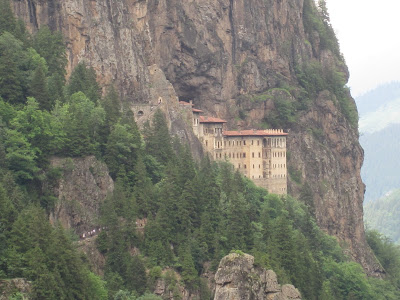While cruising the Black Sea last summer, visiting Trabzon, in northwest Turkey, we took a bus ride into Altindere National Park to visit Sumela Monastery, a monastery on a cliff high above a valley in the mountains.
It is said that the monastery was founded by two priests in 386 AD, during the reign of the Emperor Theodosius, after the priests discovered an icon of the Virgin Mary in a cave, the cave that is now the chapel on the site.
It went through periods of decline and restoration, including an enlargement and restoration during the rule of Justinian, by his General Belisarius, in the 7th century. After the Ottoman conquest, Sultan Mehmed II granted the monastery protection in 1461 which continued by later sultans. It was seized by the Russians during World War I, and held by the Russians from 1916 to 1918, when the treaty of Brest-Litovsk returned it to the Ottomans. The Ottomans surrendered later that year, along with the Germans, Austrians and Bulgarians and new countries were carved out. Mustafa Kemal, later named Ataturk, led a Turkish insurgence against the Greeks which eventually resulted in the Treaty of Lausanne between the new Republic of Turkey and Greece. A transfer of approximately 2 million people between Greece and Turkey occurred, the Greeks returning to Greece, and Sumela Monastery was abandoned in 1923. In 1930, the sacred Virgin Mary icon and other treasures, including books from the library, were relocated to a monastery in Macedonia, Greece which was founded by those who had left Sumela. Now Sumela is primarily a tourist attraction.
The aqueduct at the entrance supplied water to the monastery.
The entrance is up a long stairway, then once inside, stairs lead down to an inner courtyard.
To the right, as you go down stairs, there is a large three-floor building on the front part of the cliff used as monk cells.
It dates from 1840. The view out the windows is fantastic.
Looking back up the stairs from the courtyard below.
The cave was converted into a church and is the oldest part of the monastery.
The Athenian monks Barnabus and Sophronius found the icon of the Virgin Mary in the cave and covered it by forming the cave into a church. They carved the cave deeper, smoothed the surfaces and put up a straight wall at the entrance. Below, a picture of Christ painted on the cave ceiling.
A picture of the Virgin Mary on one of the cave walls.
A closer view of the angels on the cave wall near the Virgin Mary.
The small chapel which jutted out the wall was added later. The church was the center of the monastery. To its left are several monastery buildings.
To its right is a large library.
Frescoes on the inner wall of the church are from the time of Alexios III of Trebizond, about 1349-1390. The frescoes on the outside of the church
and
and
date from the beginning of the 18th century and are badly damaged. The frescoes are biblical scenes from the story of Christ and the Virgin Mary. The fresco below is of the 2nd Council of Nicaea, with Emperor Constantine VI, who presided, in the center.
It put an end to the iconoclastic controversy and admitted the worship of images in churches. Finally, near the entrance to the monastery is a set of buildings which contain, among other things, restrooms. I include a picture because the setting is so beautiful.
Sources: Wikipedia: Sumela Monastery and a number of other websites.



















The first photograph would make a great poster... breathtaking view!
ReplyDeleteI believe that fresco of the council of nicea is Nicea I, not Nicea II.
ReplyDeleteThe council of Nicea II admitted the veneration of, not the worship of, images.
Pangolin, I've checked several sources which state the fresco is of Nicea II. That doesn't mean it is so, but I didn't find anything that contradicted it (although it was a limited search). I'll grant you that veneration, not worship, is correct.
ReplyDelete